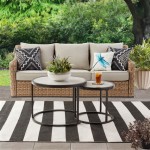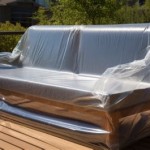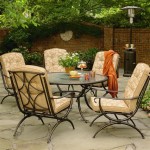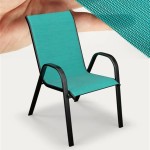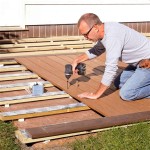How To Clean Green Algae From Patio Cushions
Green algae, a common sight in damp and humid environments, can quickly colonize outdoor patio cushions. This unsightly growth not only detracts from the aesthetic appeal of your outdoor living space but can also contribute to the degradation of the cushion fabric over time. Moreover, algae can harbor mold and mildew, posing potential health risks. Therefore, regular cleaning and preventative measures are essential to maintain the cleanliness and longevity of patio cushions.
The proliferation of green algae on patio cushions is influenced by several factors. Abundant moisture, often due to rainfall, dew, or improper drainage, creates a conducive environment for algae growth. Sunlight, while generally beneficial, can also indirectly promote algae growth by warming the moisture on the cushion surface. Furthermore, the presence of organic matter, such as fallen leaves, dirt, and bird droppings, provides a nutrient source for the algae to thrive. Cushions that are rarely used or cleaned are particularly susceptible to algae infestation.
Before commencing any cleaning procedure, it is crucial to identify the type of fabric comprising the patio cushions. Different fabrics react differently to various cleaning agents. Some fabrics are more durable and can withstand harsher cleaning methods, while others are delicate and require gentler treatment. Consult the manufacturer's care instructions, which are typically found on a tag attached to the cushion. If the care instructions are unavailable, perform a spot test on an inconspicuous area of the cushion to assess the fabric's reaction to the cleaning solution.
Preparation is key to effective algae removal. Begin by removing any loose debris, such as leaves, twigs, and dirt, from the cushion surface. This can be accomplished using a brush, vacuum cleaner, or a leaf blower. Removing this debris prevents it from interfering with the cleaning process and potentially staining the fabric. Next, gather the necessary cleaning supplies, ensuring they are appropriate for the type of fabric being cleaned. Common cleaning agents include mild dish soap, vinegar, baking soda, and specialized outdoor fabric cleaners. Also, ensure access to a water source, such as a garden hose or a bucket of water.
Cleaning with Mild Soap and Water
For most patio cushions, a solution of mild dish soap and water is a safe and effective cleaning method. This method is particularly suitable for fabrics that are not heavily soiled and for routine maintenance cleaning. Dish soap is generally gentle on fabrics while still possessing sufficient cleaning power to remove algae and other surface contaminants.
To prepare the cleaning solution, mix a small amount of mild dish soap with warm water in a bucket. The ideal ratio is typically one to two tablespoons of soap per gallon of water. Avoid using excessive amounts of soap, as it can be difficult to rinse thoroughly and may leave a residue that attracts dirt. Stir the mixture well to ensure the soap is fully dissolved.
Apply the soapy water to the affected areas of the cushion using a soft-bristled brush or a sponge. Gently scrub the surface of the cushion in a circular motion, paying particular attention to areas with visible algae growth. Avoid applying excessive pressure, as this can damage the fabric fibers. Allow the soapy water to sit on the cushion for a few minutes to loosen the algae. This dwell time allows the cleaning solution to penetrate the algae cells and break them down.
Rinse the cushion thoroughly with clean water to remove all traces of soap. Residual soap can attract dirt and promote further algae growth. Use a garden hose with a gentle spray nozzle or a bucket of clean water to rinse the cushion. Ensure that all areas of the cushion are thoroughly rinsed. After rinsing, gently press the cushion to remove excess water. Avoid wringing or twisting the cushion, as this can damage the fabric or the internal filling.
Allow the cushion to air dry completely in a well-ventilated area. Avoid placing the cushion in direct sunlight, as this can fade the fabric. Cushions can be placed on a drying rack or hung from a clothesline to facilitate air circulation. Ensure that the cushion is completely dry before storing or using it. Moisture trapped within the cushion can promote mold and mildew growth.
Using Vinegar for Algae Removal
Vinegar, specifically white distilled vinegar, is a natural and effective cleaning agent for removing green algae from patio cushions. Vinegar's acidity helps to kill algae and inhibit its growth. It is a relatively safe and environmentally friendly alternative to harsh chemical cleaners. However, it is essential to test vinegar on an inconspicuous area of the cushion before applying it to the entire surface, as it can potentially discolor some fabrics.
Prepare a cleaning solution by mixing equal parts white distilled vinegar and water in a spray bottle. The ratio can be adjusted depending on the severity of the algae growth. For heavily infested cushions, a stronger solution of vinegar may be necessary. For more delicate fabrics, a more diluted solution is recommended.
Spray the vinegar solution liberally onto the affected areas of the cushion. Ensure that the algae-covered areas are thoroughly saturated. Allow the vinegar solution to sit on the cushion for approximately 15 to 30 minutes. This dwell time allows the vinegar's acidity to penetrate and kill the algae cells. After the dwell time, scrub the cushion with a soft-bristled brush to remove the loosened algae. Use gentle, circular motions to avoid damaging the fabric.
Rinse the cushion thoroughly with clean water to remove all traces of vinegar. Vinegar has a distinct odor that some may find unpleasant, so thorough rinsing is essential. Repeat the rinsing process if necessary to ensure that all vinegar residue is removed. After rinsing, gently press the cushion to remove excess water. Allow the cushion to air dry completely in a well-ventilated area. The vinegar odor will dissipate as the cushion dries.
Implementing Preventative Measures
Preventing algae growth is often more effective than attempting to remove it. Implementing preventative measures can significantly reduce the frequency and severity of algae infestations on patio cushions. These measures involve controlling moisture, promoting air circulation, and regularly cleaning the cushions.
Controlling moisture is crucial for preventing algae growth. Ensure that the patio area is well-drained and that water does not accumulate around the cushions. Use patio furniture covers during periods of heavy rain or when the cushions are not in use. These covers protect the cushions from moisture and prevent algae from taking hold. Store cushions indoors or in a dry, covered area during the off-season. This reduces their exposure to moisture and prevents algae growth during periods of prolonged inactivity.
Promoting air circulation helps to dry out cushions quickly and prevents the formation of a damp environment conducive to algae growth. Position the cushions in a way that allows air to circulate freely around them. Avoid overcrowding the patio area with furniture, as this can restrict airflow. Periodically fluff the cushions to improve air circulation within the filling. This also helps to distribute moisture evenly and prevents the formation of damp pockets.
Regular cleaning is essential for preventing algae buildup. Wipe down the cushions regularly with a damp cloth to remove dirt, debris, and spills. This prevents organic matter from accumulating on the cushion surface and providing a nutrient source for algae. Periodically wash the cushions using a mild soap and water solution, as described earlier. This removes any algae that may have started to grow and helps to keep the cushions clean and fresh. Consider applying a fabric protectant to the cushions. These protectants create a barrier that repels water and prevents algae from adhering to the fabric. Reapply the protectant according to the manufacturer's instructions.
Furthermore, consider the placement of your patio furniture relative to potential sources of algae spores. Shaded areas are more prone to algae growth than sunny areas. If possible, position your patio furniture in a location that receives ample sunlight. Regularly inspect nearby trees and shrubs for algae growth. If algae is present, treat the plants with an appropriate fungicide to prevent the spores from spreading to the patio cushions.

How To Clean Outdoor Cushions

Wet Forget Outdoor Mildew Remover For Patio Furniture Life S Dirty Clean Easy

How To Clean Patio Cushions By The Cards We Drew

How To Remove Algae From Outdoor Cushions Green Goddess

My Patio Cushion Covers Were Covered In Mould Algae I Got Them Looking Brand New With A 1 50 Buy The Sun

How To Clean Outdoor Cushions Furn Com

How To Clean Outdoor Cushions Furn Com

How To Clean Patio Cushions By The Cards We Drew

How To Clean Patio Furniture With Wet And Forget Outdoor Blog

Clean Outdoor Cushions Save Top Tips
See Also

